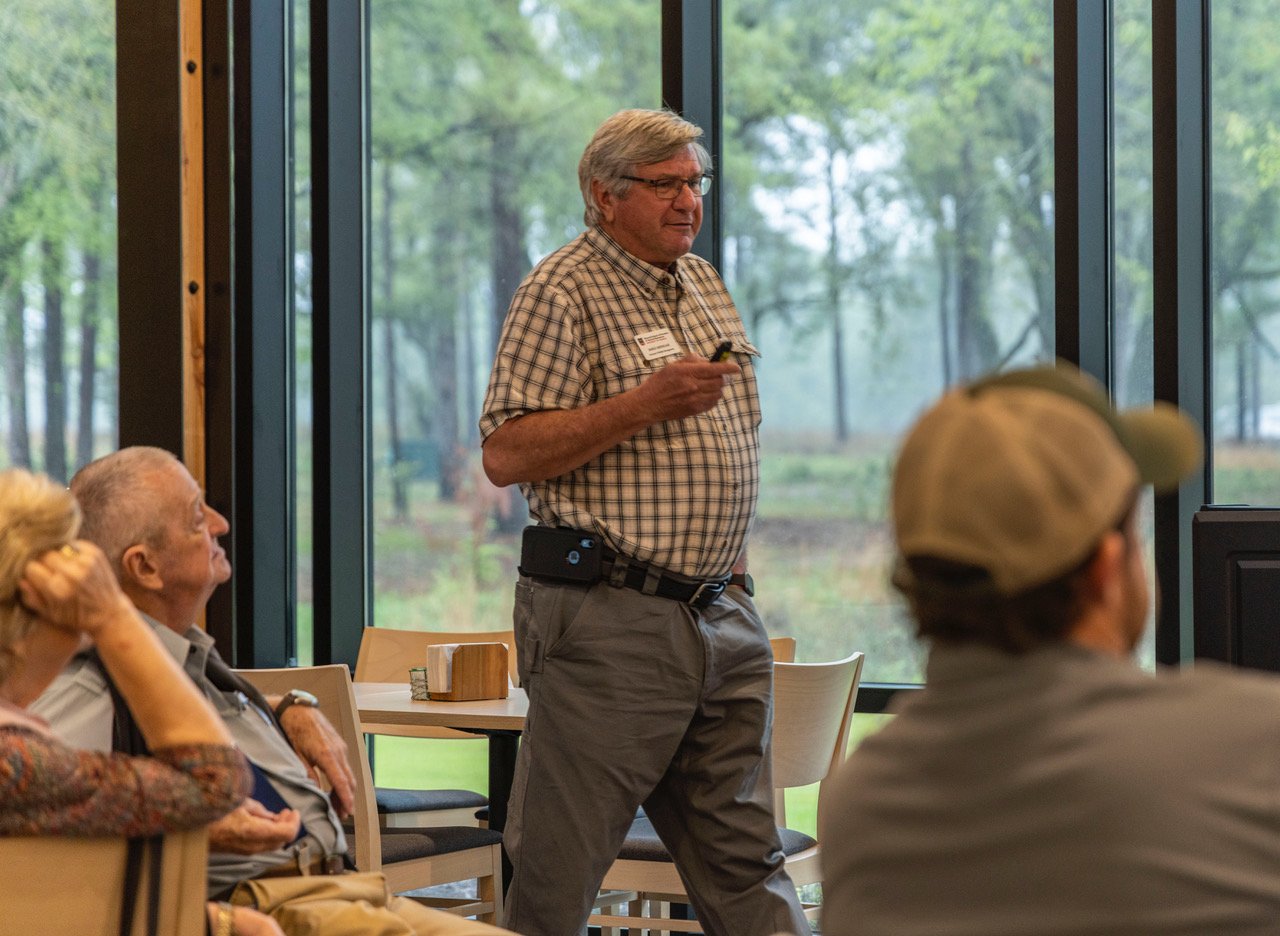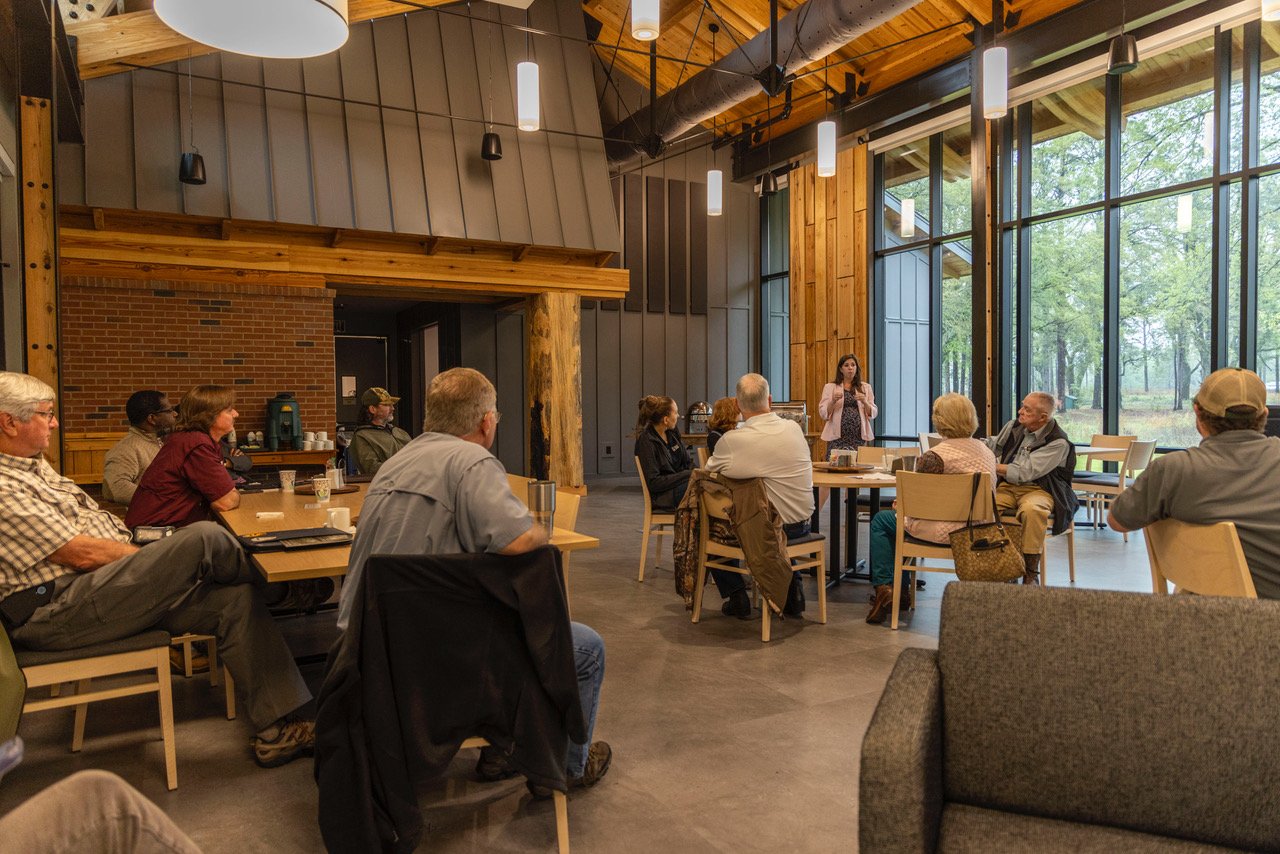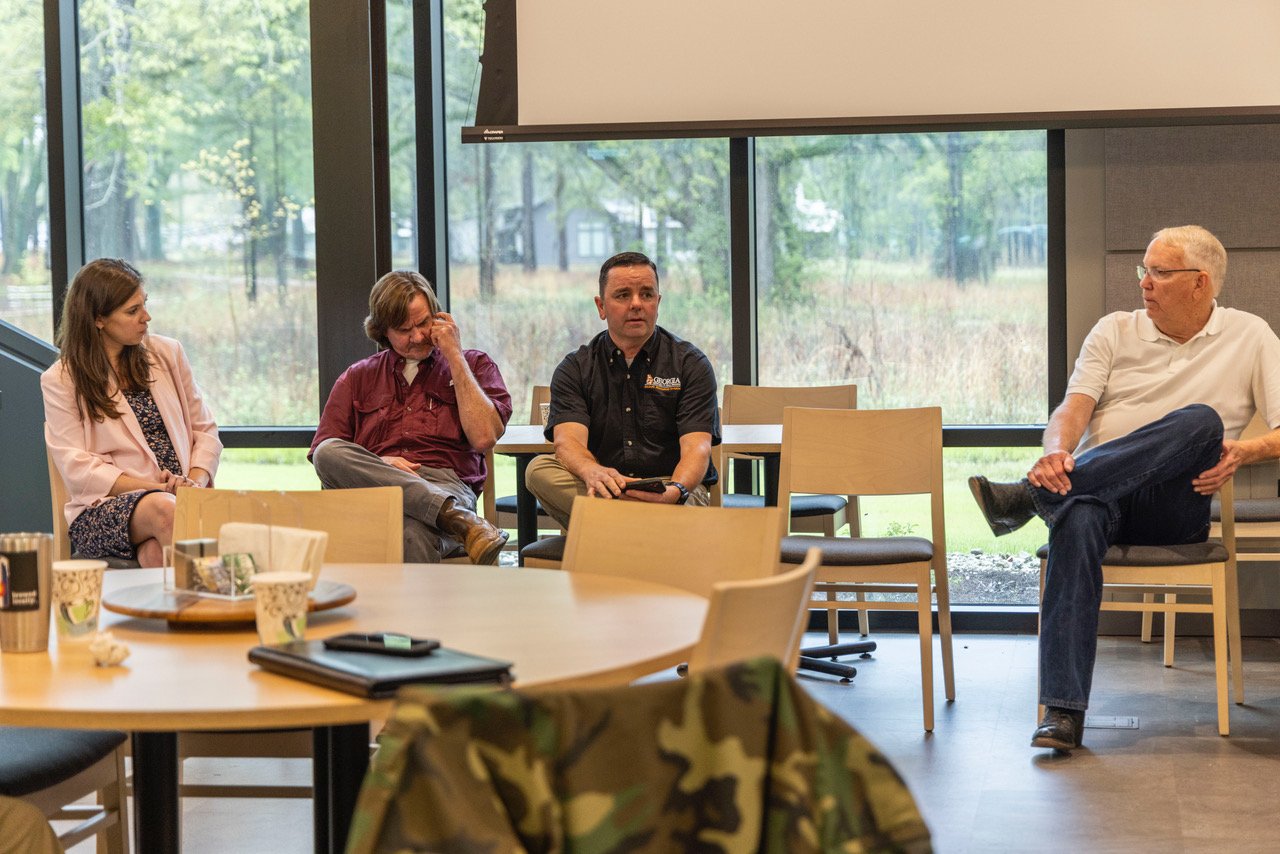Feral Swine Issues and Initiatives Highlighted at Inter-Agency Field Day Event




Photos by Matt Hanner of Motion House Media.
Federal, state and local stakeholders convened on March 27 to address the growing issue of, and innovative solutions to address, feral swine in Georgia. The event was hosted by the Flint River Soil and Water Conservation District (the District) and held at the Jones Center at Ichauway in Newton, Georgia. The nearly 30 attendees included representatives from Congressman Bishop’s office, Senator Warnock’s office, United States Department of Agriculture Natural Resource Conservation Service (USDA-NRCS) and Animal Plant and Health Inspection Service (USDA-APHIS), Georgia Department of Natural Resources, University of Georgia Warnell School of Forestry and Natural Resources, College of Agriculture and Environmental Sciences, and Savannah River Ecology Laboratory, Georgia Soil and Water Conservation Commission, Albany State University Water Planning and Policy Center, the Jones Center at Ichauway, and impacted landowners and managers. This intersection of stakeholders resulted in robust discussion and demonstrated need for ongoing collaborative solutions to address feral swine at the federal, state and local level.
“The Flint River Soil and Water Conservation District is excited about the opportunity to convene federal, state, and local stakeholders and impacted landowners to discuss this issue and spotlight innovative and collaborative solutions,” says Marty McLendon, Chairman of the District. “This is the first step to continuing this conversation not only for our District, but throughout the state and region where invasive feral swine have become such a critical concern.”
Dr. Kier Klepzig, Director of the Jones Center at Ichauway, welcomed attendees to the Jones Center and Crossroads Facility, where the event was held.
Perri Cooper, Executive Director of the District, introduced the days speakers and topics.
“It is so great to see staffers from our federal representatives, our state agencies, and local landowners and stakeholders together in one room,” Cooper says. “We are all acutely aware of the issue, and I hope the theme of today is really highlighting collaborative solutions that we can build on moving forward.”
Following the welcome, Dr. Michael Mengak, Wildlife Specialist at the Warnell School of Forestry and Natural Resources, highlighted the context of the feral swine issues in Georgia and across the United States. Specifically, how their high reproductive rate, their generalist diet, and how human impact lend itself to an exploding population.
“They have the highest reproductive rate of any animal their size on the planet,” Mengak says. “If deer can have two [offspring] in a year, and we know we have a deer problem, well a wild pig can have about 10 [offspring in a year].
Mengak also highlighted the importance of the interplay of high reproductive rates as it relates to effective control techniques.
“There is no such thing as a one and done in control; the number removed doesn’t matter as much as the number left behind.”
Findings and successes of two pilot projects in the Feral Swine Control and Eradication Pilot Program authorized through the 2018 Farm Bill were highlighted for attendees.
Dr. Steve Golladay, Affiliate Biologist at the Jones Center at Ichauway and Senior Research Associate at the Albany State University Water Planning and Policy Center and Dr. Mike Conner, Wildlife Ecology Scientist at the Jones Center at Ichauway, shared research results from the Albany Area Pilot Project.
The Albany Area pilot project conducted research on 25,000 acres in Calhoun County, Georgia over two years. Objectives of this research included assessing feral swine populations and native wildlife populations, efficacy of the Judas Pig technique for control, water quality, and crop damage over two years in conjunction with intensive control efforts led by USDA-APHIS.
Throughout the project, both continuous water quality monitoring as well as monthly water sampling provided critical data to understand the impact of feral swine on water quality. In partnership with the University of Georgia Tifton Veterinary Diagnostics Lab, water samples were also tested for ecoli, and, if present, source traced to measure specifically the ecoli levels attributed to feral swine.
“With continuous water monitoring, we can see peaks in sedimentation on an otherwise clear night and attribute it to feral swine movement” says Golladay. “When cross referenced with camera and eDNA data, we can actually quantify their water quality impact. This is bigger than any one landowner, this is a much larger watershed issue.”
Conner emphasized the negative impact of feral swine observed in the research conducted on native wildlife populations and habitat.
“Typically in wildlife management we explore tradeoffs, but with [feral swine] I just don’t see a benefit,” says Conner.
Caitlin Kupferman, Research Coordinator at the Savannah River Ecology Laboratory then highlighted research conducted in the South Carolina Pilot Project, also authorized through the Feral Swine Control and Eradication Pilot Project, which covered three counties and observed a 70 percent reduction in feral swine populations. The project also measured feral swine damage through ground surveying on a sample of properties in the project, over half of which observed zero feral swine damage after two years of intensive control, led by USDA-APHIS.
“It’s great to see these removal efforts, but what does that mean for the [feral swine] left on the landscape? How do we maintain these gains if there are gaps in funding?” posed Caitlin K.
The importance of federal programs that provide resources, expertise, and funding for control efforts were shown to be critically important through these pilot projects, however state and local efforts were held in tandem with this federal program. A panel during the event highlighted these efforts.
Wesley Webb, a Calhoun County farmer, Steve Singletary, an Early County landowner, and Brian Vickery, Georgia DNR Regional Supervisor, served on this panel which was moderated by Cooper.
Webb, who farms in the footprint of the Albany Area Pilot Project, emphasized the positive impact of the intensive control efforts through the project, particularly the reduced damage to his agricultural fields year after year during the project timeline.
Singletary was one of several landowners that collaborated with the District and USDA-APHIS Wildlife Services to conduct and weeklong aerial control project. This project included over 20,000 acres across the cooperating landowners and removed 178 feral swine. Singletary highlighted how a cooperative aerial project complimented the ongoing ground control efforts conducted by participating landowners in the area.
Vickery highlighted not only the negative impact of feral swine on public lands, but also the partnership at the state level through the revamped Georgia Feral Hog Task Force to provide education, outreach and resources to impacted landowners.
Matt Ondovchik, Feral Swine Coordinator for USDA-APHIS Wildlife Services, provided closing remarks to attendees. USDA-APHIS is a critical partner for all of the various control efforts across the state, including the Feral Swine Eradication and Control Pilot Program, aerial projects, and the Georgia Feral Hog Task Force.
“We’ve revamped the Feral Hog Task Force to launch a trap lease program, and have a goal to have a helicopter dedicated to the state of Georgia for aerial projects,” Ondovchik highlighted, reinforcing the theme of collaborative and cooperative models that was a throughline of the event.
“This is largely dependent on federal, state and cooperator funds. It is really a conglomeration.”
The Flint River Soil and Water Conservation District is comprised of farmers, landowners, and community leaders that are dedicated to the conservation, wise use, and protection of natural resources in the Flint River Basin. Learn more about the District at flintriverswcd.org. Learn more about the issue and solutions to feral swine control in Georgia at georgiaferalswine.com. Reach out to feralswine@flintriverswcd.org with questions about feral swine programming in Georgia. This material is based upon work supported by the U.S. Department of Agriculture, under Agreement number NR204310XXXXG001.
